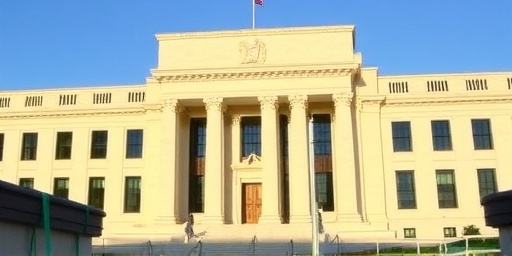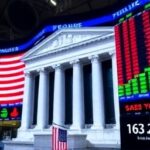In a move that sent shockwaves through financial markets, the Federal Reserve has signaled a potential interest rate cut as early as December, buoyed by the latest CPI data indicating that inflation has cooled to 2.4%. This dovish pivot from the U.S. central bank comes after months of steadfast policy amid persistent price pressures, offering a glimmer of relief to consumers and businesses grappling with elevated borrowing costs.
The announcement, delivered during the Fed’s latest policy meeting, underscores a shifting economic landscape where cooling inflation is finally gaining traction. Chair Jerome Powell emphasized the progress, stating, “We are seeing meaningful disinflation across the board, which positions us well to consider easing interest rates if the data continues to cooperate.” Markets reacted swiftly, with the S&P 500 surging 1.5% and the Dow Jones Industrial Average climbing over 400 points in a single session, reflecting heightened investor confidence in a softer monetary stance.
Dissecting the CPI Report: Key Drivers of Cooling Inflation
The cornerstone of the Fed’s optimism lies in the freshly released Consumer Price Index (CPI data), which clocked in at a 2.4% year-over-year increase for October—the lowest reading since February 2021. This marks a significant deceleration from the 2.6% recorded in September and a stark contrast to the double-digit peaks seen in 2022 during the height of post-pandemic inflation.
Core CPI data, which strips out volatile food and energy prices, rose 3.3%, down from 3.4% the prior month. Economists attribute this easing to several factors. Shelter costs, a persistent thorn in the side of inflation fighters, increased by just 4.9% annually, the slowest pace in over two years. Meanwhile, energy prices dipped 2.1%, with gasoline falling 4.6% amid ample global supply and subdued demand.
Grocery prices, another area of concern for households, advanced only 1.1%, reflecting improved supply chains and a retreat from the supply disruptions of earlier years. “The CPI data paints a picture of an economy where inflation is no longer the runaway train it once was,” noted Harvard economist Dr. Elena Ramirez in a post-release analysis. “This gives the Federal Reserve the breathing room it needs to pivot without risking a reacceleration.”
However, not all indicators are green. Used vehicle prices rebounded slightly by 2.8%, and apparel costs ticked up 1.5%, hinting at pockets of lingering pressure. Overall, the report reinforces the narrative of a gradual unwind, with monthly CPI data showing a mere 0.2% gain—below expectations and signaling sustained momentum toward the Fed’s 2% target.
Market Surge: Investors Bet on Dovish Fed Policy
The Federal Reserve‘s hints at lower interest rates ignited a broad market rally, with equities leading the charge. Bond yields tumbled, as the 10-year Treasury note dipped to 4.1%, its lowest in weeks, while mortgage rates followed suit, averaging 6.8% for a 30-year fixed loan—a potential boon for the housing market.
Wall Street’s enthusiasm stems from the prospect of rate relief after a year of aggressive hikes that pushed the benchmark federal funds rate to a 23-year high of 5.25%-5.50%. Traders now price in a 75% chance of a 25-basis-point cut in December, up from 50% pre-meeting, according to CME FedWatch Tool data. “This is the signal markets have been craving,” said JPMorgan Chase strategist Michael Feroli. “Lower interest rates could unlock pent-up demand in everything from autos to real estate.”
Tech stocks, sensitive to borrowing costs, outperformed with the Nasdaq Composite jumping 2.1%. Companies like Apple and Nvidia saw gains of over 3%, as investors anticipate cheaper capital for innovation and expansion. Conversely, the U.S. dollar weakened against major currencies, falling 0.8% versus the euro, which could aid exporters but pressure import-dependent sectors.
Yet, the rally wasn’t without caution. Volatility spiked briefly as some analysts warned of over-optimism. “While the CPI data is encouraging, the labor market remains robust, which might temper the Fed’s aggressiveness,” cautioned Goldman Sachs’ Lindsay Rosner. Still, the overall sentiment remains bullish, with portfolio managers reallocating toward risk assets in anticipation of a more accommodative Federal Reserve.
Impact on Everyday Americans: From Mortgages to Wallets
For the average American, the prospect of easing interest rates translates to tangible relief. Homebuyers, sidelined by rates above 7% earlier this year, could see renewed affordability. The National Association of Realtors estimates that a 0.5% drop in mortgage rates might boost home sales by 10-15% in the coming quarters, injecting vitality into a stagnant market.
Credit card debt, now averaging $6,500 per household, stands to benefit as variable rates tied to the prime rate decline. “Lower interest rates mean less money funneled to lenders and more back in consumers’ pockets,” explained Consumer Financial Protection Bureau Director Rohit Chopra during a recent briefing. Auto loans, too, could soften, with average rates potentially falling from 7.5% to around 6.5%, encouraging vehicle purchases amid an aging fleet.
On the savings front, however, yields on high-interest accounts and CDs—currently offering 4-5%—may erode, prompting retirees to rethink strategies. “Savers have enjoyed elevated returns, but a rate cut cycle will shift the balance toward borrowers,” said Fidelity Investments advisor Sarah Chen.
Inflation‘s retreat also eases the squeeze on essentials. With food inflation at bay, families might redirect spending toward discretionary items, supporting retail and services sectors. Yet, wage growth, hovering at 4.1%, outpaces inflation, preserving real income gains for many and reducing recession fears.
Global Ripples: How U.S. Policy Influences the World Economy
The Federal Reserve‘s dovish turn reverberates far beyond U.S. borders, influencing global interest rates and trade dynamics. Emerging markets, long burdened by a strong dollar and high U.S. yields, breathed a sigh of relief. Brazil’s central bank, for instance, signaled its own potential easing, citing synchronized inflation trends.
In Europe, the European Central Bank faces pressure to follow suit, as Eurozone CPI data mirrors the U.S. at 2.5%. “The Fed’s lead often sets the tone for global monetary policy,” observed IMF Chief Economist Pierre-Olivier Gourinchas. Commodities markets reacted positively, with oil prices stabilizing at $75 per barrel and gold climbing to $2,050 an ounce as a hedge against uncertainty.
Trade implications are mixed. A weaker dollar could narrow the U.S. trade deficit by making exports more competitive, but it might stoke inflation imports in dollar-pegged economies like those in the Middle East. Asian manufacturers, from South Korea to Vietnam, anticipate a boost in demand for U.S.-bound goods as lower interest rates stimulate consumption.
Geopolitical tensions add layers of complexity. With ongoing conflicts in Ukraine and the Middle East, energy inflation risks persist, potentially forcing the Federal Reserve to recalibrate. Nonetheless, the current trajectory suggests a more stable global outlook, fostering cooperation among central banks.
Looking Ahead: Economic Indicators and Fed’s Next Moves
As the Federal Reserve navigates this pivotal moment, upcoming data releases will be scrutinized intensely. November’s employment report, due Friday, could tip the scales—if job growth slows below 150,000, it might accelerate rate cut expectations. The Personal Consumption Expenditures (PCE) index, the Fed’s preferred inflation gauge, is slated for release later this month and could confirm the CPI data‘s downward trend.
Powell has stressed a data-dependent approach, warning against premature easing that could reignite inflation. Projections from the Fed’s Summary of Economic Projections suggest two cuts by mid-2024, aligning with a soft landing scenario where growth holds at 2.1% and unemployment stays below 4.5%.
Business leaders are optimistic. In a survey by the National Association for Business Economics, 62% of executives expect interest rates to decline within six months, spurring investment in capital expenditures. Consumers, per University of Michigan polls, report improved sentiment, with expectations of inflation at 2.8%—the lowest since 2021.
The path forward hinges on sustained progress. If CPI data and other metrics continue to cool, December’s meeting could mark the start of a new era of monetary easing, bolstering economic resilience. For now, the Federal Reserve‘s signal serves as a beacon of hope, guiding markets and policymakers toward stability in an uncertain world.









